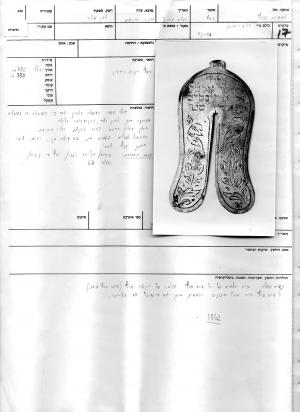Obj. ID: 11020
Sacred and Ritual Objects Circumcision shield, Tunis, 20th century

The circumcision shield is a rounded oval plate with a central slit and a small rectangular handle on top. Its front face is decorated with a dedicatory inscription and two leafy branches.
The dedication is engraved in square Hebrew letters, and reads:
"כבוד/ אליהו אנבי (הנביא)/ יוסף די נסים/ שמלה ס"ט (סופו טוב)."
"(Made for) the honour of the prophet Elijah, Joseph (son) of Nissim Shamla, may his end be well."
Summary and Remarks
- The circumcision shields all over the world are similarly shaped, with minor changes. Their shape is attuned to their function as the protectors of the baby's glans during the removal of the foreskin. The shields differ in their decorations which usually define their origin. Each community embellished the implements according to its characteristic style (figs. 1, 2; Berger, "Instruments," 1997, p. 40, fig. 12). In North Africait was also customary to inscribe the name of the mohel on the implements he used. For comparisons see the blades used by the mohalim Jacob Zror and Abraham Isaac, who were both active in Tunis in the beginning of the 20th century. For their implements, see: Circumcision knife, Sc.82(PC)-16, and Eudel, Dictionnaire des Bijoux, 1906, p. 164).
Remarks
sub-set tree:
Name/Title
Magen HaBrit | Unknown
Object
Object Detail
Monument Setting
Unknown
Date
20th century
Synagogue active dates
Reconstruction dates
Artist/ Maker
Unknown
Historical Origin
Unknown
Community type
Congregation
Location
Unknown |
Site
Unknown
School/Style
Unknown|
Period Detail
Documentation / Research project
Unknown
Iconographical Subject
Unknown |
Textual Content
Unknown |
Languages of inscription
Unknown
Shape / Form
Unknown
Material / Technique
Material Stucture
Material Decoration
Material Bonding
Material Inscription
Material Additions
Material Cloth
Material Lining
Tesserae Arrangement
Density
Colors
Construction material
Measurements
Height
Length
Width
Depth
Circumference
Thickness
Diameter
Weight
Axis
Panel Measurements
Condition
Extant
Documented by CJA
Surveyed by CJA
Present Usage
Present Usage Details
Condition of Building Fabric
Architectural Significance type
Historical significance: Event/Period
Historical significance: Collective Memory/Folklore
Historical significance: Person
Architectural Significance: Style
Architectural Significance: Artistic Decoration
Urban significance
Significance Rating
0
Ornamentation
Custom
Contents
Codicology
Scribes
Script
Number of Lines
Ruling
Pricking
Quires
Catchwords
Hebrew Numeration
Blank Leaves
Direction/Location
Façade (main)
Endivances
Location of Torah Ark
Location of Apse
Location of Niche
Location of Reader's Desk
Location of Platform
Temp: Architecture Axis
Arrangement of Seats
Location of Women's Section
Direction Prayer
Direction Toward Jerusalem
Coin
Coin Series
Coin Ruler
Coin Year
Denomination
Signature
Colophon
Scribal Notes
Watermark
Hallmark
Group
Group
Group
Group
Group
Trade Mark
Binding
Decoration Program
Suggested Reconsdivuction
History/Provenance
Nissim Shamla was a well known circumciser (mohel) in Tunis. He studied his profession from R. David Perez, who practiced his occupation as a mohel in the capital city at the end of the 19th and the beginning of the 20th century. Perez had several students, among them Makhluf Elbaz, Jacob Hababo and Hai Levy, whose circumcision implements also survived, Sc.82(PC)-16.
Perez immigrated to Israel in the 1950s and continued to practice his profession till the day he died.
The shield was one of the circumcision tools of Nissim's son, Joseph, who learned his profession from his father.
Main Surveys & Excavations
Sources
• Berger, Natalia. "Instruments for Circumcision-Ritual Objects or Surgical Tools?." In Rimonim (5, 1997). Ed. Sabar, Shalom, 29-42. Jerusalem: Society for Jewish Art. In Hebrew.
• Eudel, Paul. Dictionnaire des Bijoux de l'Afrique du Nord. Ernest Leroux, Éditeur, 1906. In French.
• Shalom, Sabar. "Pregnancy, Childbirth and Early Childhood." In The Life Cycle. Ed. Sabar Shalom, 14-91. Jerusalem: Ben-Zvi Institue for Study of Jewish Communities in the East, 2006. In Hebrew.
Type
Documenter
|
Author of description
|
Architectural Drawings
|
Computer Reconstruction
|
Section Head
|
Language Editor
|
Donor
|
Object Copyright
Sc_082
Negative/Photo. No.
The following information on this monument will be completed:
Unknown |



